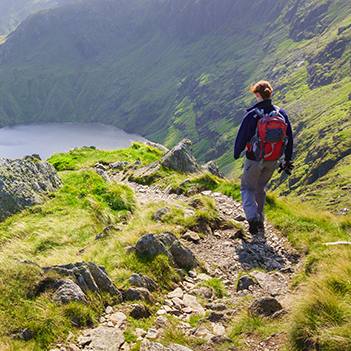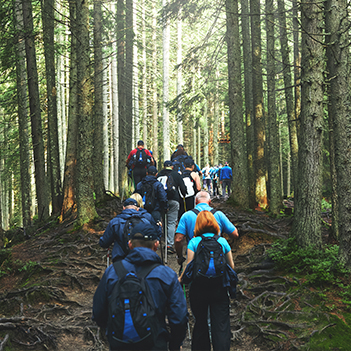Walk from Grainings Wood
18 enthusiasts turned out expecting a soaking for most of the day, but the reality was that the rain only lasted for about forty minutes or so, the views remaining clear and even the sun put in an appearance for the final few miles.
The route initially took us round the now drained Jack’s Key reservoir, which in the late 1800s and early 1900s, was a popular boating lake, picnic spot and had a large tearoom provided. Once over the A66, the first climb of the day took us up on to Darwen Moor, passing Duckshaw Brook on the Witton Weavers Way, then up above Duckshaw Clough, through Lyon’s Den to our lunch stop at the car park and cafe at Tockholes.
Once past Ryal Fold and Fine Peter’s Farm, on the second leg of the walk, initially a gentle ascent along the ancient packhorse route of Dean Lane soon led down into Sunnyhurst Wood, the first of the three larger parks in Darwen to be visited. It was then down through the emerging new leaves of spring to the old bandstand, then a steep climb out of the wood to emerge by the Sunnyhurst pub, a short climb on a narrow path at the end of which, some thought that Darwen Tower beckoned, but not today. We turned left on a belvedere path above the town of Darwen, which eventually took us to the entrance of Bold Venture Park, probably the most picturesque of the three parks, with its ornamental lake, waterfalls and formal gardens. Once out of the park after another climb, Limersgate was followed. In Anglo-Saxon times, this was the main packhorse route for carrying lime from Lancashire to Yorkshire. In view for most of this section was the 300ft high India Mill Grade 11 listed chimney, said to be modelled on one in Venice. We then exited into Bury Fold an old hamlet where we viewed Bury Fold House, built in 1675. Further down the lane is Lowhill House, built in 1812 by Samuel Crompton, the inventor of the Spinning Mule. Passing by some very deep scenic wooden cloughs, two mills by the stream where viewed, one the Print Shop, built in 1791 as a water powered carding and spinning mill. Calico printing was also started here in 1810. The final stage of the walk took us on the final climb of the day, though and out of Whitehall Park and down a section of the developing West Pennine link route of the Pennine Bridleway. Approx. 10 miles walked.







